Este es mi reporte de la tercera parte del proyecto de ciencia ciudadana. En la parte anterior, simulamos colisiones como las que se producen en el Gran Colisionador de Hadrones del CERN. Para más detalles, pueden leer mi reporte o el de cualquiera de mis compañeros de proyecto en la etiqueta #citizenscience. En esta parte, vamos a analizar los resultados que obtuvimos. Para más detalles sobre el proyecto, pueden ingresar a este post de @lemouth, que es quien está liderando este experimento en Hive.
Como el archivo que obtuvimos en la parte anterior es muy grande para analizarlo manualmente (cosa que tampoco sabría hacer…), tuvimos que instalar un nuevo software, MadAnalysis5, con el que reemplazamos, en palabras de lemouth, “los cientos de partículas producidas por un pequeño número de objetos de nivel superior como electrones, muones, jets, fotones y energía perdida”.
Antes de comenzar con la instalación del software, hice un cambio en la configuración de la máquina virtual en la que estoy corriendo el software. En la segunda parte, el proceso de Phytia8 me había llevado más de 50 minutos. Por recomendación de lemouth, le aumenté la cantidad de procesadores a la máquina virtual de 1 a 2.
This is my report on the third part of the citizen science project. In the previous part, we simulated collisions like those at CERN's Large Hadron Collider. For more details, you can read my report or that of any of my project colleagues under the hashtag #citizenscience. In this part, we are going to analyze the results we obtained. For more details about the project, you can enter this post by @lemouth, who is leading this experiment at Hive.
As the file we obtained in the previous part is too large to analyze manually (which I wouldn't know how to do either...), we had to install a new software, MadAnalysis5, with which we replaced, in lemouth's words, "the hundreds of produced particles by a small number of higher-level objects like electrons, muons, jets, photons and missing energy".
Before starting with the installation of the software, I made a change to the configuration of the virtual machine on which I am running the software. In the second part, the Phytia8 process had taken me more than 50 minutes. On lemouth's recommendation, I increased the number of processors in the virtual machine from 1 to 2.
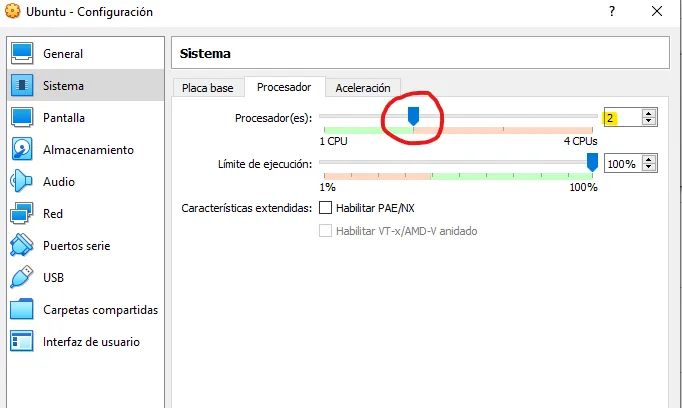
Luego, traté de descargar MadAnalysis5 de github, pero no tenía git instalado, así que instalé git primero.
Next, I tried to download MadAnalysis5 from github, but I didn't have git installed, so I installed git first.

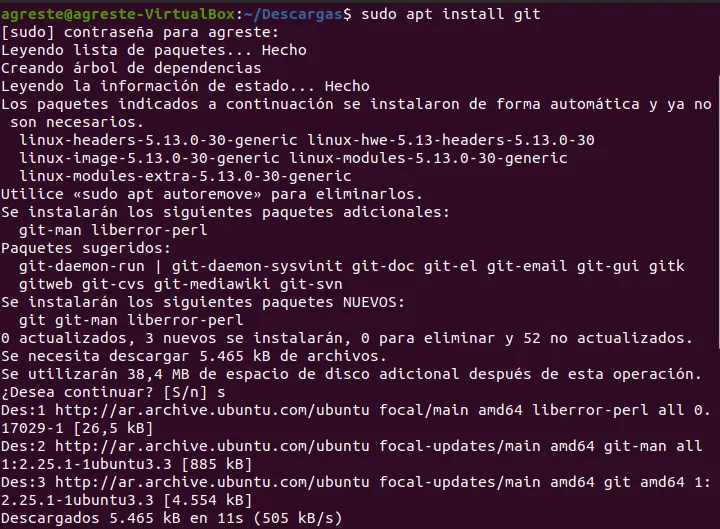
Y luego sí pude descargar MadAnalysis5.
And then I was able to download MadAnalysis5.

Para correr el software, simplemente hay que abrir la carpeta donde fue descargado y ejecutarlo, pero en mi caso no funcionó.
To run the software, you simply open the folder where it was downloaded and run it, but in my case it didn't work.

Entonces, fui a la etiqueta #citizenscience para ver si algún compañero ya había hecho el reporte y si había tenido el mismo problema. Afortunadamente, encontré este post de @servelle (¡muchas gracias!), quien había tenido el mismo problema y había encontrado que la solución era instalar el paquete python-is-python3.
So, I went to the #citizenscience tag to see if any colleagues had already made the report and if they had had the same problem. Fortunately, I found this post by @servelle (thank you very much!), who had had the same problem and had found that the solution was to install the python-is-python3 package.
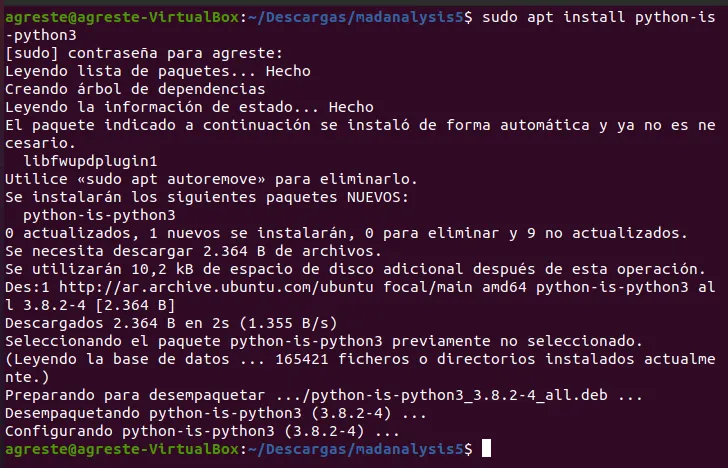
Una vez instalado ese paquete, pude finalmente correr ma5 sin problemas.
Once that package was installed, I was finally able to run ma5 without problems.
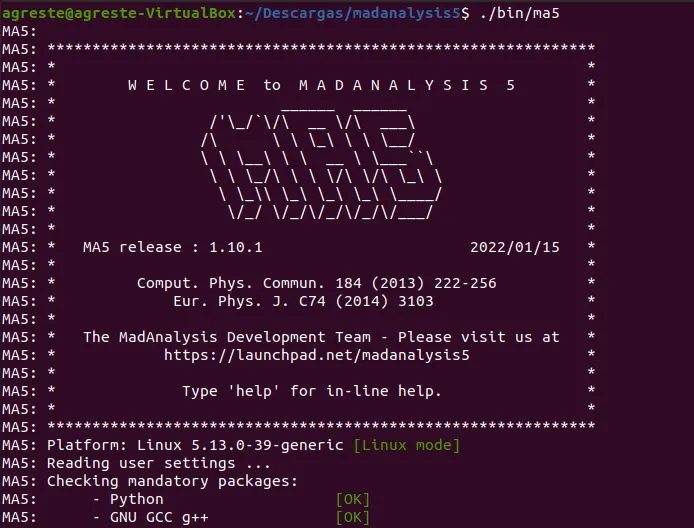
Dejé toda la configuración como estaba por defecto.
I left all the configuration as it was by default.

Y entonces ma5 comenzó a compilar.
And then ma5 started compiling.
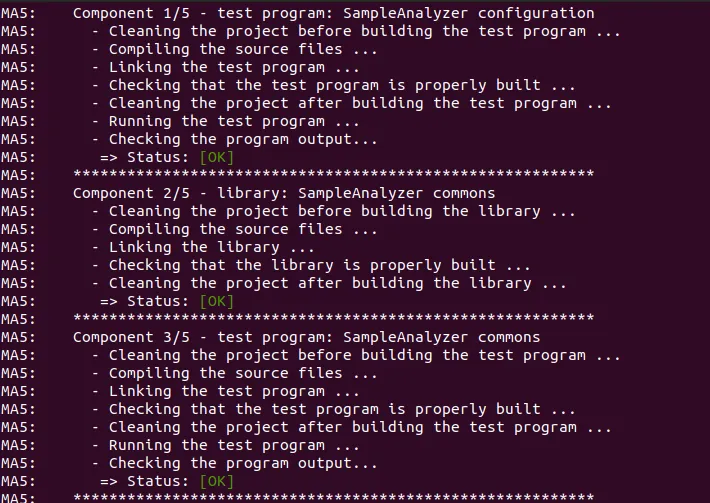
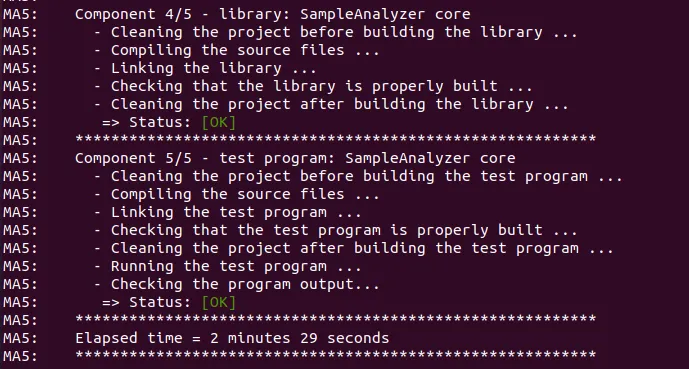
Finalmente, ma5 chequeó las dependencias externas. En mi caso, todas estaban desactivadas.
Finally, ma5 checked for external dependencies. In my case, they were all disabled.

De todos esos paquetes, los necesarios para esta tarea son: matplotlib, latex y pdflatex. Así que tuve que salir de ma5 con el comando exit.
Of all those packages, the ones needed for this task are: matplotlib, latex and pdflatex. So I had to exit ma5 with the exit command.

Luego, tuve que instalar el paquete python3-pip.
Then, I had to install the python3-pip package.
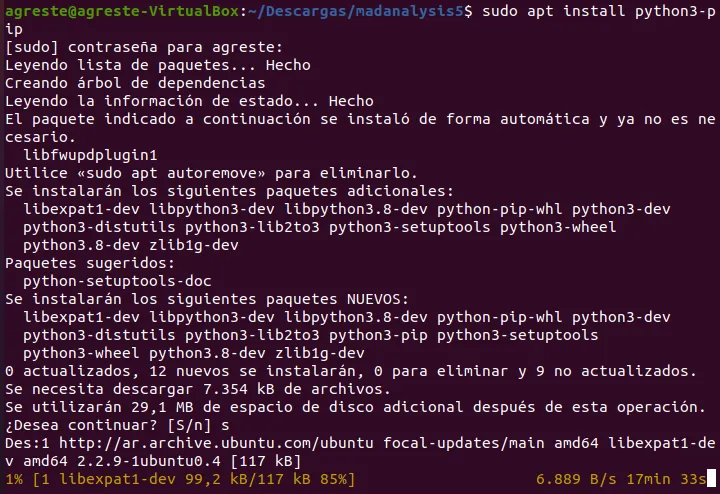
Y finalmente matplotlib con el comando: pip install matplotlib.
And finally matplotlib with the command: pip install matplotlib.
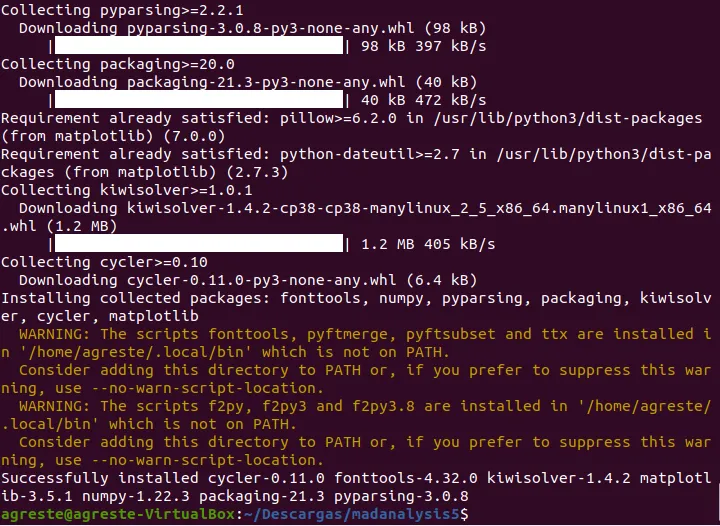
Luego, instalé el paquete texlivefull. Este proceso demora mucho tiempo.
Then, I installed the texlivefull package. This process takes a long time.
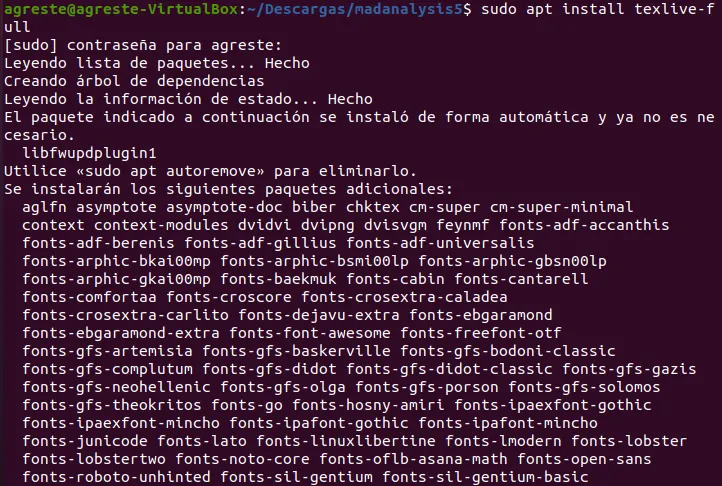
Una vez instalado, corrí de nuevo ma5 y ya estaban habilitados matplotlib, latex y pdflatex.
Once installed, I ran ma5 again and matplotlib, latex and pdflatex were enabled.
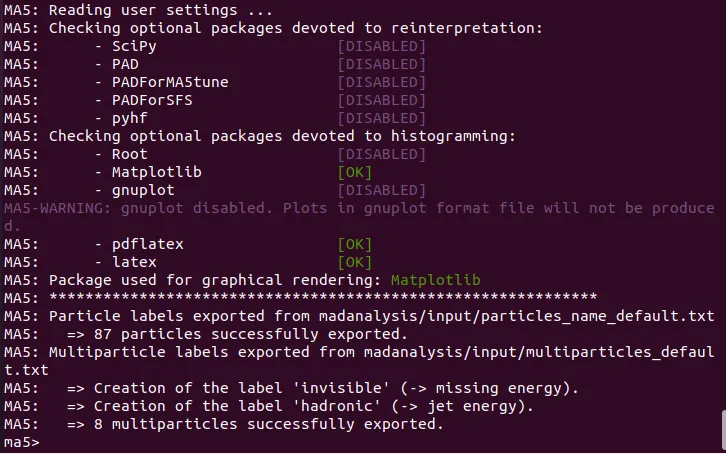
El siguiente paso era instalar dos paquetes adicionales para ma5, zlib y fastjet, mediante el comando install. En ambos casos, la instalación pide reiniciar ma5.
The next step was to install two additional packages for ma5, zlib and fastjet, using the install command. In both cases, the installation asks to restart ma5.

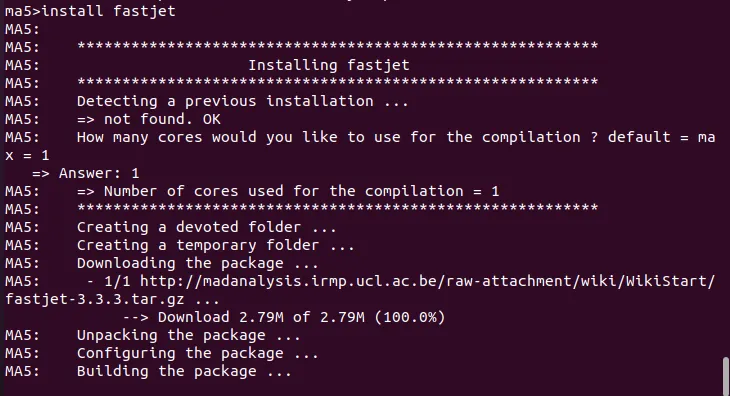
Y finalmente, zlib y fastjet ya están habilitados.
And finally, zlib and fastjet are enabled.
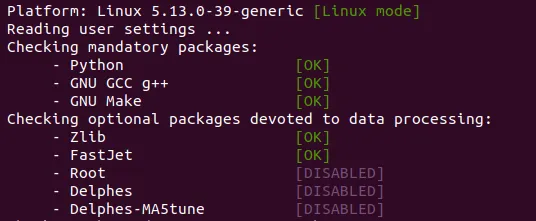
Ahora que todo estaba listo, tocaba importar el archivo que generamos en la parte anterior a ma5. Para eso, salí de ma5 con el comando exit y lo reinicié de este modo.
Now that everything was ready, it was time to import the file we generated in the previous part to ma5. For that, I exited ma5 with the exit command and restarted it like this.

Luego, escribí estos comandos (usando el path al archivo creado en la parte anterior):
Then, I typed these commands (using the path to the file created in the previous part):
import <path-to-our-events>
set main.outputfile = miseventos.lhe.gz
submit
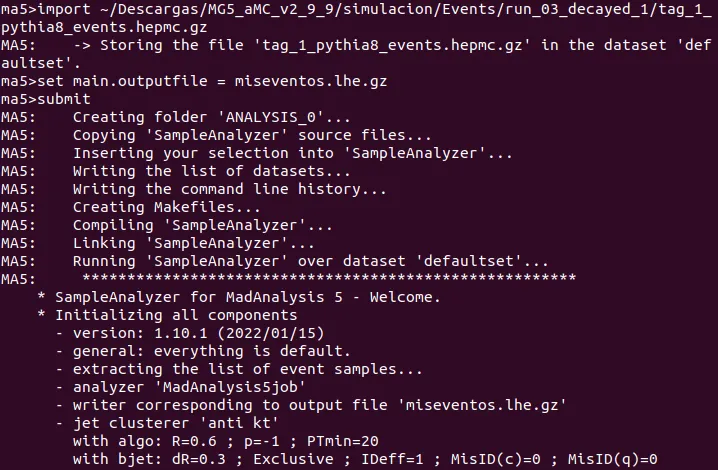
Finalmente, salí de ma5 con el comando exit. Un archivo de texto se generó en ANALYSIS_0/Output/SAF/_defaultset/lheEvents0_0. El contenido de ese archivo es algo como esto:
Finally, I exited ma5 with the exit command. A text file was generated in ANALYSIS_0/Output/SAF/_defaultset/lheEvents0_0. The contents of that file look something like this:
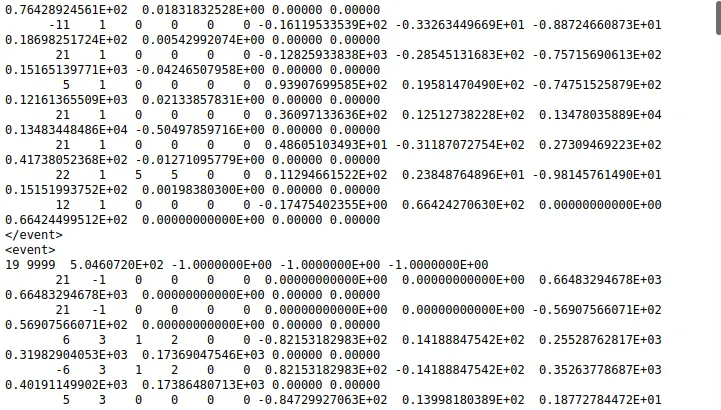
Para analizar el archivo, volví a iniciar ma5 de la forma normal. Luego, importé el archivo generado:
To parse the file, I restarted ma5 in the normal way. Then, I imported the generated file:

Luego, escribí los siguientes comandos:
Then, I typed the following commands:
set ttbar.xsection = 505.491
plot NAPID
submit
Y ma5 comenzó a hacer los cálculos.
And ma5 started to do the calculations.
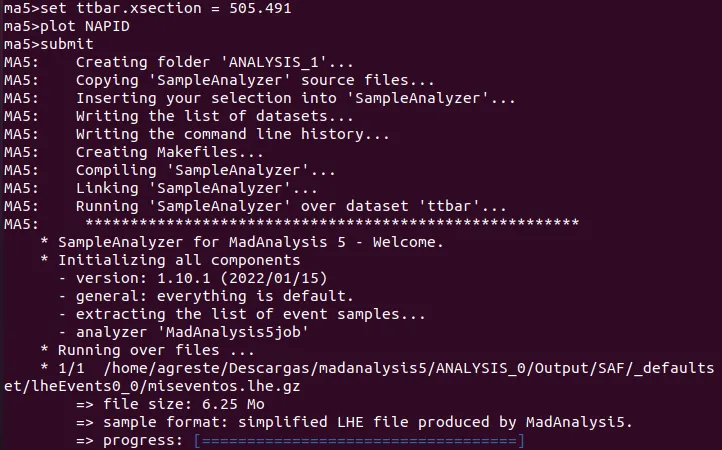
Y, por último, con el comando open obtuve este gráfico.
And finally, with the open command I got this plot.
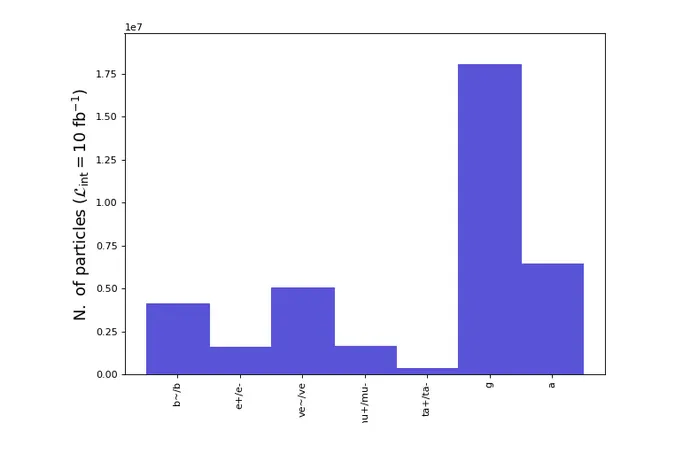
Y esto es todo por ahora. El próximo episodio estará dedicado solo a la física.
And that's all for now. The next episode will be dedicated only to physics.
Original en español. Traducido al inglés con Deepl.
Todas las imágenes son capturas de pantallas del proceso hechas por mí.
Original in Spanish. Translated to English with Deepl.
All images are screenshots of the process made by me.